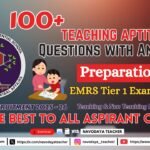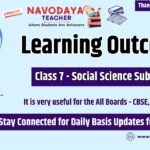In this article we providing information regarding latest Learning Outcomes for Class 7 Science Subject in PDF
Learning Outcomes for Class 7 Science Subject in PDF 2024
The learner —
- Identifies materials and organisms, such as, animal fibres; types of teeth; mirrors and lenses, on the basis of observable features, i.e., appearance, texture, functions, etc.
- Differentiates materials and organisms such as, digestion in different organisms; unisexual and bisexual flowers; conductors and insulators of heat; acidic, basic and neutral substances; images formed by mirrors and lenses, etc., on the basis of their properties, structure and function
- Classifies materials and organisms based on properties/characteristics, e.g., plant and animal fibres; physical and chemical changes
- Conducts simple investigations to seek answers to queries, e.g., can extract of coloured flowers be used as acid-base indicator? Do leaves other than green also carry out photosynthesis? Is white light composed of many colours?
- Relates processes and phenomena with causes, e.g., wind speed with air pressure; crops grown with types of soil; depletion of water table with human activities, etc.
- Explains processes and phenomena, e.g., processing of animal fibres; modes of transfer of heat; organs and systems in human and plants; heating and magnetic effects of electric current, etc.
- Writes word equation for chemical reactions, e.g., acid-base reactions; corrosion; photosynthesis; respiration, etc.
- Measures and calculates e.g., temperature; pulse rate; speed of moving objects; time period of a simple pendulum, etc.
- Draws labelled diagrams/ flow charts e.g., organ systems in human and plants; electric circuits; experimental set ups; life cycle of silk moth, etc.
- Plots and interprets graphs e.g., distance time graph
- Constructs models using materials from surroundings and explains their working, e.g., stethoscope; anemometer; electromagnets; newton’s colour disc ,etc.
- Discusses and appreciates stories of scientific discoveries
- Applies learning of scientific concepts in day-to-day life, e.g., dealing with acidity; testing and treating soil; taking measures to prevent corrosion; cultivation by vegetative propagation; connecting two or more electric cells in proper order in devices; taking measures during and after disasters; suggesting methods for treatment of polluted water for reuse, etc.
- Makes efforts to protect environment, e.g., following good practices for sanitation at public places; minimising generation of pollutants; planting trees to avoid soil erosion; sensitising others with the consequences of excessive consumption of natural resources, etc.
- Exhibits creativity in designing, planning, making use of available resources, etc.
- Exhibits values of honesty, objectivity, cooperation, freedom from fear and prejudices
Thanks to Beloved Readers.













